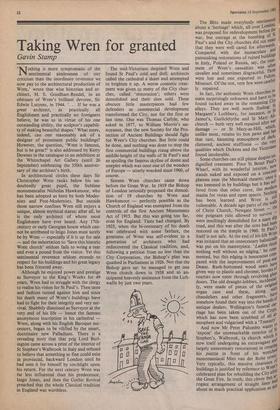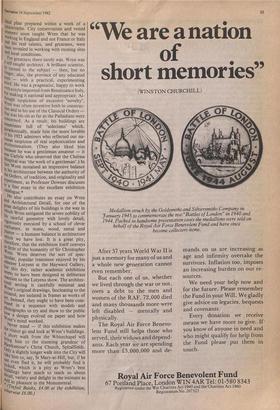Taking Wren for granted
Gavin Stamp
`Nothing is more symptomatic of the sentimental aimlessness of our criticism than the inordinate reverence we now pay to the architectural production of Wren,' wrote that wise historian and ar- chitect, H. S. Goodhart-Rendel, in an obituary of Wren's brilliant devotee, Sir Edwin Lutyens, in 1944. If he was a great architect, as practically all Englishmen and practically no foreigners believe, he was so in virtue of his one outstanding ability, the sculptor's capabili- ty of making beautiful shapes.' What more, indeed, can one reasonably ask of a designer of prominent public buildings? However, the question, `Wren is famous, but is he great?' is also addressed by Kerry Dowries in the catalogue to an exhibition at the Whitechapel Art Gallery (until 26 September) celebrating the 350th anniver- sary of the architect's birth.
In architectural circles these days Sir Christopher Wren ranks below his un- doubtedly great pupil, the Sublime monumentalist Nicholas Hawksmoor, who has been adopted as hero by both Moder- nists and Post-Modernists. But outside those narrow confines Wren still enjoys a unique, almost mythical status; after all, he is the only architect of whom most Englishmen have ever heard. Any 17th- century or early Georgian house which can- not be attributed to lnigo Jones must surely be by Wren — especially if it is up for sale — and the exhortation to 'Save this historic Wren church' seldom fails to wring a tear and even a pound from the visitor. Yet this sentimental reverence seldom extends to respect for his buildings and his great legacy has been frittered away.
Although he enjoyed power and prestige as Surveyor to the King's Works for 49 years, Wren had to struggle with the clergy to realise his vision for St Paul's. Then taste and fashion turned against him and since his death many of Wren's buildings have had to fight for their integrity and very sur- vival. Shabbily dismissed as Surveyor at the very end of his life — hence the famous anonymous inscription in his cathedral Wren, along with his English Baroque suc- cessors, began to be vilified by the smart, doctrinaire new Palladians. There is a revealing story that that prig Lord Burl- ington came across a print of the interior of St Stephen's Walbrook in Italy and refused to believe that something so fine could exist in provincial, backward London until he had seen it for himself by torchlight upon his return. For the next century Wren was far less influential than his predecessor, Inigo Jones, and then the Gothic Revival preached that the whole Classical tradition in England was worthless. The mid-Victorians despised Wren and found St Paul's cold and dull; architects called the cathedral a sham and attempted to brighten it up. A worse cosmetic treat- ment was given to many of the City chur- ches, called `restoration'; others were demolished and their sites sold. These obscure little masterpieces had few defenders as commercial development transformed the City, not for the first or last time. One was Thomas Carlyle, who asked in 1877, to William Morris's an- noyance, that the new Society for the Pro- tection of Ancient Buildings should fight for Wren's City churches. But little could be done, and nothing was done to stop the first commercial buildings rising above the middle-height of the walls of St Paul's and so spoiling the famous skyline of dome and steeples which was once one of the wonders of Europe — utterly wrecked since 1960, of course.
Sixteen Wren churches came down before the Great War. In 1919 the Bishop of London seriously proposed the demoli- tion of 19 churches by Wren and Hawksmoor — perfectly possible as the Church of England was exempted from the controls of the first Ancient Monuments Act of 1913. But this was going too far, even for England. Taste had changed. By 1923, when the bi-centenary of his death was celebrated with some fanfare, the greatness of Wren was self-evident to a generation of architects who had rediscovered the Classical tradition, and, following a petition from no less than the City Corporation, the Bishop's plan was quashed in Parliament in 1926. Not that the Bishop gave up: he managed to get one Wren church down in 1938 and so an- ticipated heavenly assistance from the Luft- waffe by just two years. The Blitz made everybody sentimental about a 'heritage' which, all over London, was proposed for redevelopment before the war, but outrage at the bombing of St Paul's and the City churches did not mean that they were well cared for afterwards. Compared with the immaculate and painstaking restorations of ruined buildings in Italy, Poland or Russia, say, the treat- ment of Wren's casualties was often cavalier and sometimes disgraceful. Three were lost and one exported to Fulton, Missouri. Of the rest, very few were careful- ly repaired. In fact, the authentic Wren churches re- main surprisingly unknown and have to he found tucked away in the remaining alleys. They are well worth finding: St Margaret's Lothbury, for instance, or St James's, Garlickhythe and St Mary Ah church — both very well repaired after war damage — or St Mary-at-Hill, which, unlike most, retains its box pews and has that rare, haunting atmosphere of dark' cluttered, ancient stuffiness — the veil qualities which Dickens and the Victorians found intolerable. City Some churches can still please despite us: dignified treatment. Poor St Benet Pall s Wharf, with its wonderful interior, now stands naked and exposed on a concrete plateau near the Mermaid theatre; once it was hemmed in by buildings but it has suf fered from that other curse, the modern mania for vistas and open spaces. Nothil has been learned and Wren is walls vulnerable. A decade ago parts of the " of Christ Church, Newgate Street — the one poignant ruin allowed to survive I were insultingly demolished for a mere slip road, and this was after the urns had bee!' restored on the steeple in 1960. St Paul itself is not safe. At the end of his life Wren was irritated that an unnecessary balustra'f, was put on his masterpiece. Ladies thin!' nothing well without an edging,' he corn' mented, but this edging is innocuous corn' pared with the improvements of post-wat Deans. Rush-bottomed wood seats have, given way to plastic and chrome; hordes of tourists now enter through revolving glass doors. The old draught-lobbies, incidental' ly, were made of pieces of the original organ case and these, along vil.,"; chandeliers and other fragments, have somehow found their way into the handso antique dealers. Wellington's funeral ear' riage has been taken out of the CIPt' which has now been scrubbed of all at mosphere and vulgarised with a `TreasurY ' And now Mr Peter Palumbo wants t.°, `expose' the unremarkable exterior of 51 Stephen's, Walbrook, (a church which Is now itself undergoing an extravagant and largely unnecessary restoration) in creattel his piazza in front of his wretch monomaniacal Mies van der Rohe tower; Very typically, this massive clearance Ts buildings is justified by reference to Wren celebrated plan for rebuilding the City alt., the Great Fire. In truth, this clever but ad rogant arrangement of straight lines ha, about as much practical application as am ideal plan prepared within a week of a catastrophe. City conservatism and vested interests soon taught Wren that he was Working in England and not France or Italy and his real talents, and greatness, were soon revealed in working with existing sites and local conditions. For greatness there surely was. Wren was self-taught architect. A brilliant scientist, Ile turned to the subject — then, but no anger, alas, the province of any educated man — with a practical, experimenting mind. He was a pragmatist, happy to work with a style imported from Renaissance Italy, .°111 making it national and appropriate. Al- hough suspicious of excessive 'novelty', ten was often inventive both in construe- Lwino and in his use of the Classical Orders was his sin as far as the Palladians were concerned. As a result, his buildings are Sometimes full of 'solecisms' which, Paradoxically, made him the more lovable t9 his 1923 admirers who reflected our na- tional suspicion of real sophistication and Professionalism. (They also liked him because he was a gentleman amateur — it was Carlyle who observed that the Chelsea Hospital was 'the work of a gentleman'.) In tact Wren sustained an impressive balance to his architecture between the authority of the Orders, of tradition, and originality and experiment, as Professor Downes discusses In a fine essay in the excellent exhibition catalogue.* He also contributes an essay on Wren and Architectural Detail, for one of the great delights of his buildings is the way in his Wren mitigated the severe nobility of ats careful geometry with lovely detail, vigorously executed by a school of clever craftsmen, in stone, wood, metal and Plaster —'a humane balance in architecture ,which we have lost. It is a great pity, therefore that the exhibition itself conveys svov little of the humanity of Sir Christopher ren. Wren deserves the sort of spec- tacular, popular treatment enjoyed by his admirer Lutyens at the Hayward Gallery, but this dry, rather academic exhibition seems to have been designed in deliberate reaetion to the Lutyens show. The architec- tural setting is carefully minimal and Wren's original drawings, fascinating to the tlated, are isolated in frames as works of 17,Lt Instead, they ought to have been com- uIned in a sequence with models and rotographs to try and show to the public wren's a design evolved on paper and how r„en's mind worked.
the mind — if this exhibition makes `lle visitor go and look at Wren's buildings. ,:" short walk from the Whitechapel will Iring him to the stunning grandeur of i nwksmoor's Christ Church, Spitalfields. a slightly longer walk into the City will ake him to, say, St Mary-at-Hill, but, if he )even find it, he will probably find it i()eked, which is a pity as Wren's best nildings have much to teach us about detail, variety and delight in the intimate as `ell as pleasure in the Monumental. (Trefoil Books, £4.00 at the exhibition, otherwise f6.00.)



































 Previous page
Previous page